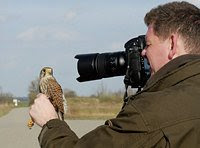Dear all,
The previous post was on the wildebeest migration. On their way through the savannah they have to cross some rivers. Swimming in dangerous water is certainly not their favorite pursuit, but their instinct and constant search for water and food drives them to the river banks. I saw this nervous spectacle quite often on television but to observe it in real life is something special ..........
 Thousands of them are waiting at the river bank, often accompanied by zebras .....
Thousands of them are waiting at the river bank, often accompanied by zebras .....

After hours of nervous waiting at the river bank, a brave one-year-old calf starts a massive crossing .....
 With hundreds per minute, they plunge themselves in the water ..... uncertain whether they reach the other side safely ..... this crossing continued for more than an hour .....
With hundreds per minute, they plunge themselves in the water ..... uncertain whether they reach the other side safely ..... this crossing continued for more than an hour .....

Where the river banks are steep they jump like athletes .....

Trying to cross the Mara river as soon as possible ..... hungry crocodiles are waiting .....
 The view after the crossing ..... the river bank is covered with exhausted wildebeest ..... some are in shock, others have broken their bones or spine ..... unable to continue their journey ..... a certain death is ahead .....
The view after the crossing ..... the river bank is covered with exhausted wildebeest ..... some are in shock, others have broken their bones or spine ..... unable to continue their journey ..... a certain death is ahead .....
 Some are 'lucky' and recover after their shock ..... but the danger is still around ..... after playing for half an hour like a cat with a mouse, this wildebeest calf was killed .....
Some are 'lucky' and recover after their shock ..... but the danger is still around ..... after playing for half an hour like a cat with a mouse, this wildebeest calf was killed .....
 After the wildebeest crossing, the Mara river is covered with hundreds of carcasses ..... leaving behind a penetrating stench of cadaverine .....
After the wildebeest crossing, the Mara river is covered with hundreds of carcasses ..... leaving behind a penetrating stench of cadaverine .....
Next post will be on the birds of the Mara plains.
See you,
Dirk-Jan
































